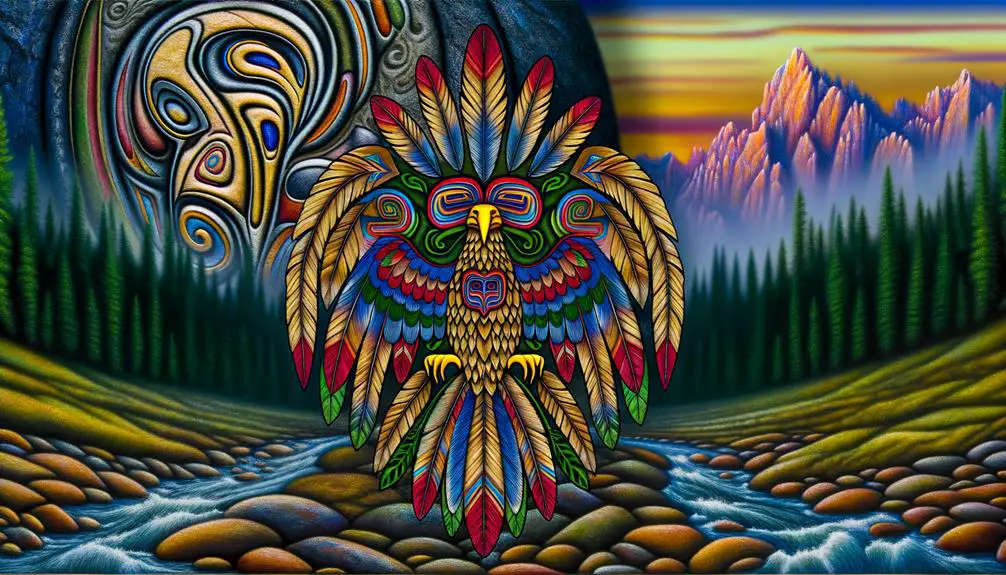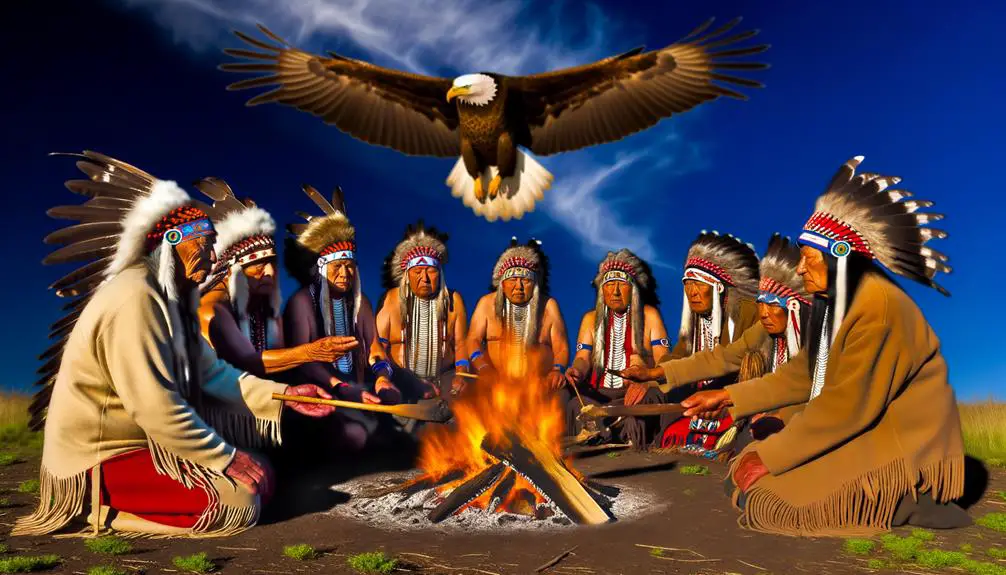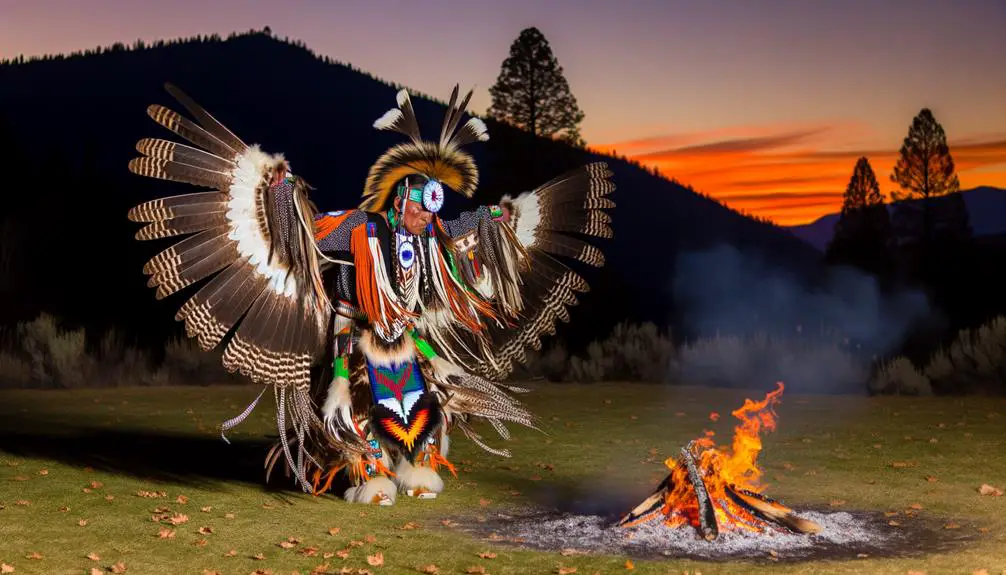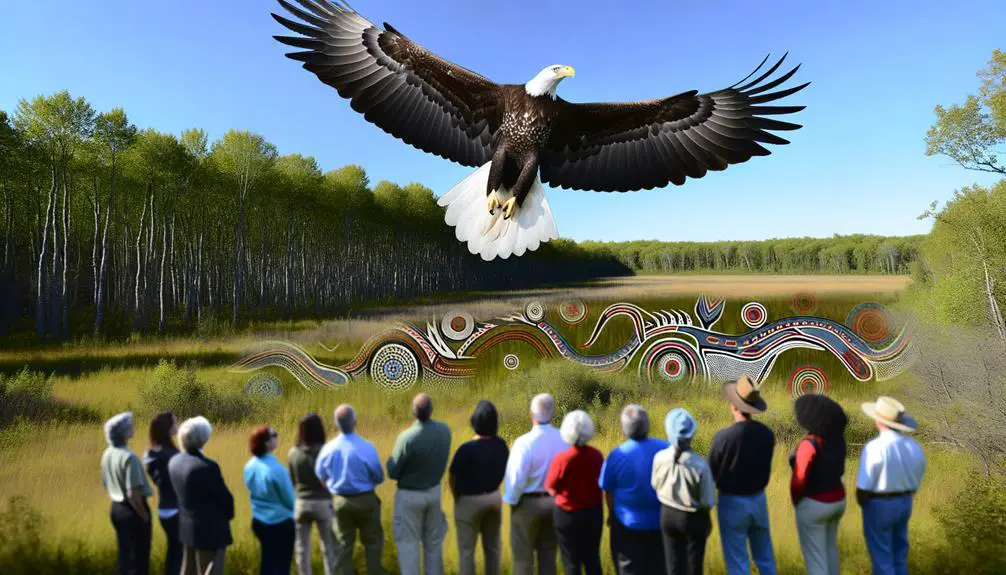How to Interpret the Meaning of the Native American Eagle Symbol
The eagle holds profound spiritual, cultural, and symbolic significance in Native American traditions. It is a powerful emblem representing vision, strength, and freedom.
Many tribes regard the eagle as a sacred being embodying wisdom, courage, and protection, often incorporating its feathers into ceremonial practices. The eagle's flight symbolizes clarity and connection to the divine, serving as a bridge between the earthly and spiritual domains.
It also epitomizes autonomy and the unbounded human spirit. Through its revered status and diverse interpretations across tribes, the eagle fosters communal harmony and spiritual elevation, inviting further exploration into its rich cultural heritage.

Key Takeaways
- The eagle symbolizes vision, clarity, and spiritual insight in Native American cultures.
- It represents strength, courage, and protection, embodying deep spiritual significance.
- Sacred eagle feathers are used in ceremonies for their divine connection.
- The eagle is seen as a bridge between the earthly and spiritual realms.
- Eagle dances honor its role as a messenger of the gods and communal unity.
Spiritual Significance

The eagle holds deep spiritual significance in Native American cultures, symbolizing a connection to the divine and serving as a powerful emblem of vision, strength, and freedom.
Revered as a messenger between the earthly and spiritual domains, the eagle's flight is often perceived as a conduit for prayers and spiritual communication. Various tribes regard the eagle as a sacred being, embodying attributes such as wisdom, courage, and protection. Eagle feathers, in particular, are considered holy and are used in ceremonial practices to invoke spiritual guidance and blessings.
The bird's keen eyesight is metaphorically linked to heightened perception and insight, underscoring its role as a spiritual guide. Therefore, the eagle occupies a central and revered place in Native American spirituality.
Symbol of Freedom
In addition to its spiritual importance, the eagle also stands as a profound symbol of freedom within Native American cultures, embodying the ideals of autonomy, resilience, and the unbounded spirit.
This majestic bird, soaring high above the earth, represents the ultimate expression of freedom, transcending physical limitations and societal constraints. The eagle's flight is often seen as a metaphor for the journey of the soul, unencumbered and liberated.
Tribes such as the Lakota and the Cherokee honor the eagle's ability to navigate vast skies, symbolizing the aspiration for personal and communal independence. This embodiment of freedom is not merely physical but deeply rooted in the cultural ethos, reflecting a profound respect for self-determination and the natural world.
Vision and Clarity

The eagle, revered in Native American cultures, epitomizes vision and clarity, symbolizing spiritual insightfulness that guides individuals on their life paths.
This majestic bird's keen sight serves as a metaphor for future foresight, enabling one to perceive opportunities and challenges from a broader perspective.
Additionally, the eagle's focused gaze embodies mental concentration, encouraging a disciplined and clear-minded approach to life's endeavors.
Spiritual Insightfulness
Eagles in Native American symbolism often embody spiritual insightfulness, representing vision and clarity that transcend the physical domain. They are revered for their ability to soar to great heights, symbolically bridging the earthly and spiritual worlds. This elevated perspective grants them unparalleled clarity, making them powerful mediators between humans and the divine.
In various tribes, the eagle's keen sight is metaphorically linked to spiritual perception, enabling individuals to see beyond the superficial and into deeper truths. This spiritual insightfulness is not merely observational but serves as a profound connection to higher wisdom and knowledge, guiding individuals on their spiritual journeys.
The eagle's presence in rituals and ceremonies underscores its role as a conduit for divine messages and enlightenment.
Future Foresight
Future foresight, as symbolized by the eagle in Native American cultures, encapsulates the profound vision and clarity required to anticipate and navigate forthcoming circumstances with wisdom. The eagle's elevated flight and keen eyesight serve as metaphors for the ability to see beyond the immediate and into the potential future. This symbolic foresight is integral to making informed decisions and guiding one's community with prudent leadership.
Essential attributes of future foresight include:
- Keen observation: Like the eagle's sharp vision, it emphasizes the importance of attentiveness.
- Strategic planning: Insight into future possibilities to craft effective strategies.
- Wisdom in decision-making: Leveraging foresight to make enlightened choices.
- Adaptability: The ability to foresee changes and adjust accordingly.
Such attributes underscore the eagle's revered status among Native American tribes.
Mental Focus
In Native American traditions, mental focus is essential for achieving a profound understanding of oneself and the world. Epitomized by the eagle's vision and clarity, this concept emphasizes the importance of heightened awareness and discernment in maneuvering life's complexities.
The eagle's acute sight serves as a metaphor for looking beyond superficial appearances and attaining deeper insights. It encourages individuals to embrace perspective and soar to great heights to observe vast landscapes, highlighting the significance of mental focus.
Connection to the Divine
Symbolizing a bridge between the earthly domain and the spiritual world, the eagle plays a pivotal role in Native American cultures as a sacred messenger to the divine. Esteemed for its majestic flight and keen vision, the eagle embodies a profound connection to higher powers and celestial spheres.
Various tribes regard the eagle with deep reverence, attributing several spiritual significances:
- Spiritual Guidance: Seen as a conduit for divine wisdom and insight.
- Protection: Believed to offer guardianship and ward off negative energies.
- Transcendence: Represents the soul's journey towards enlightenment and higher consciousness.
- Omnipresence: Emblematic of an all-seeing, all-knowing presence in the spiritual hierarchy.
The eagle's esteemed status underscores its integral role in facilitating communion with the divine, reflecting a deep-rooted spiritual heritage.
Role in Ceremonies

Frequently integral to a multitude of sacred rituals, the eagle's presence in Native American ceremonies underscores its profound spiritual and cultural significance.
The eagle is often perceived as a messenger between the earthly domain and the divine, its soaring flight symbolizing a connection to higher powers.
In various tribal traditions, eagles are invoked during prayer ceremonies, healing rites, and seasonal celebrations to invoke blessings, protection, and guidance.
Dances and songs specifically dedicated to the eagle serve to honor its revered status, ensuring the continuity of cultural heritage.
The eagle's role in these ceremonies is not merely symbolic but is believed to facilitate spiritual elevation and communal harmony, reflecting the deep respect Native American cultures have for this majestic bird.
Sacred Feathers
Sacred feathers from the eagle hold profound ceremonial uses, often serving as essential components in rituals and traditional practices. Their spiritual significance transcends mere symbolism, embodying the connection between the physical and spiritual spheres.
Additionally, these feathers are imbued with deep cultural importance, reflecting the reverence and respect Native American communities have for the eagle as a messenger and protector.
Ceremonial Uses
In various Native American cultures, eagle feathers hold profound ceremonial significance. They are often regarded as conduits for spiritual connection and revered as sacred objects in numerous rituals and traditions. These feathers are meticulously integrated into ceremonies to symbolize honor, strength, and the divine.
Healing Rituals:
Eagle feathers are used to purify and heal individuals, believed to carry prayers to the Great Spirit.
Ceremonial Dress:
Feathers embellish regalia worn during dances and ceremonies, signifying reverence and communal harmony.
Feather Tying:
In some tribes, feathers are fastened into hair or onto objects to bestow blessings and protection.
Rite of Passage:
Presenting eagle feathers marks significant life changes, honoring achievements and maturity.
Such uses underscore their deep cultural and spiritual significance.
Spiritual Significance
Eagle feathers are venerated across numerous Native American cultures for their profound spiritual significance, symbolizing a direct connection to the divine and the embodiment of sacred wisdom. These feathers are believed to carry prayers to the heavens, acting as mediators between humans and the Creator. They encapsulate the qualities of strength, courage, and vision, and are often used in rituals to invoke healing and protection. The spiritual potency of eagle feathers is not merely symbolic but is deeply integrated into the lived spiritual experiences of the people.
| Symbolism | Cultural Meaning | Spiritual Role |
|---|---|---|
| Sacred Wisdom | Strength and Courage | Mediators to the Divine |
| Divine Connection | Vision and Insight | Carriers of Prayers |
| Protection and Healing | Ritualistic Use | Embodiment of Spirituality |
Cultural Importance
Across various Native American tribes, the feathers of the eagle hold immense cultural importance, revered not only as sacred objects but also as essential elements of identity and heritage. These feathers are often used in ceremonies, symbolizing a connection to the divine and the spiritual domain. The significance of eagle feathers can be observed in various cultural practices:
- Ceremonial Use: Integral in rituals and dances, embodying spiritual guidance and protection.
- Honor and Respect: Awarded for acts of bravery and significant achievements within the community.
- Healing Practices: Believed to possess curative powers, aiding in physical and spiritual healing.
- Cultural Identity: Representing the tribe's history, values, and connection to the natural world.
These aspects underscore the profound reverence for eagle feathers in Native American culture.
Eagle in Mythology

Throughout various Native American cultures, the eagle is often revered as a powerful spiritual figure deeply embedded in mythology and storytelling.
This majestic bird is frequently associated with the divine, serving as a messenger between the earthly and the spiritual domain.
In many legends, the eagle symbolizes strength, wisdom, and vision, often depicted as a protector and guide.
Its ability to soar to great heights is seen as a metaphor for transcendence and a connection to the Creator.
The eagle's keen sight is emblematic of insight and foresight, qualities highly valued in leadership and spiritual guidance.
Therefore, the eagle's role in mythology is multifaceted, reflecting its esteemed position in the cultural and spiritual life of Native American peoples.
Tribal Variations
The eagle's symbolism in Native American cultures is not monolithic, as its meaning varies greatly across different tribes.
While some tribes view the eagle as a messenger of the gods, others regard it as a symbol of bravery and leadership.
These regional differences underscore the rich tapestry of cultural significance attributed to the eagle, reflecting the diverse spiritual and social landscapes of Native American communities.
Regional Symbolism Differences
Although the eagle is an important symbol for many Native American tribes, its specific meanings and associations can vary widely among different regions and cultural groups. The diverse interpretations reflect the rich tapestry of Native American spirituality and culture.
For example:
- Lakota Sioux: The eagle represents a connection to the Great Spirit and is seen as a messenger between the material world and the heavens.
- Hopi: Eagles are associated with prayers for rain and fertility, playing a crucial role in ceremonial dances.
- Cherokee: The eagle is a symbol of peace and carries prayers to the Creator.
- Haida: Among Pacific Northwest tribes, the eagle is emblematic of power, vision, and resourcefulness.
Understanding these regional variations underscores the nuanced and profound role the eagle plays in Native American life.
Cultural Significance Variations
Exploring the cultural significance of the eagle across various Native American tribes reveals a rich tapestry of meanings that extend beyond regional interpretations. Among the Lakota, the eagle is revered as a sacred messenger, bridging the physical and spiritual domains.
The Cherokee, however, view the eagle as a symbol of peace and harmony, often invoking its spirit in ceremonial practices. In contrast, the Hopi regard the eagle as an embodiment of strength and courage, integral to their kachina rituals.
The diversity in interpretations underscores the eagle's profound, multifaceted role in Native American spirituality, encapsulating themes of power, wisdom, and connection to the divine. This intricate symbolism highlights the eagle's revered status across diverse tribal cultures.
Eagle Dances

Eagle dances hold profound cultural significance among many Native American tribes, serving as both a spiritual practice and a celebration of the revered eagle's symbolic importance. These dances often encapsulate a deep connection to the natural world, reflecting the eagle's role as a messenger between the spiritual and earthly domains.
Integral aspects of eagle dances include:
- Sacred Costumes: Crafted with feathers and regalia symbolizing the eagle's grandeur.
- Ceremonial Songs: Chants and music that invoke spiritual presence and guidance.
- Ritual Movements: Choreographed steps mimicking the eagle's flight and behaviors.
- Community Participation: Involving tribal members in a collective expression of reverence.
Each element underscores the eagle's esteemed place in Native American spirituality, fostering a sense of unity and cultural continuity.
Modern Interpretations
In contemporary contexts, the eagle symbol continues to be a potent emblem within Native American communities, reflecting both traditional values and modern adaptations. Today, the eagle is often seen in artistic expressions, such as paintings, jewelry, and digital media, symbolizing strength, freedom, and spiritual guidance.
Additionally, contemporary Native American leaders invoke the eagle in public discourse to emphasize resilience and unity. Educational programs incorporate the eagle to teach younger generations about heritage and ethical principles.
Despite evolving mediums, the essence of the eagle as a sacred messenger and protector remains steadfast, illustrating a dynamic continuity between ancient traditions and present-day cultural identity. This fusion underscores the enduring relevance of the eagle in modern Native American life.
Preservation Efforts

Efforts to preserve the cultural and spiritual significance of the eagle symbol among Native American communities are multifaceted, covering legal protections, educational initiatives, and collaborative projects with conservation organizations.
These efforts include:
- The Bald and Golden Eagle Protection Act: Legal measures that protect eagles from hunting and exploitation, recognizing their cultural importance.
- Educational Programs: Initiatives aimed at passing traditional knowledge about eagle symbolism to younger generations within Native communities.
- Conservation Partnerships: Collaborations with wildlife organizations to guarantee eagle populations remain healthy and abundant.
- Cultural Resource Management: Strategies to integrate eagle symbolism into broader cultural preservation projects, ensuring its continuity and relevance.
Such thorough approaches are essential for safeguarding the enduring legacy of the eagle among Native American peoples.
Conclusion
To sum up, the Native American eagle symbol holds profound spiritual and cultural significance, embodying freedom, vision, and divine connection across various tribes.
Interestingly, a 2018 study revealed that 78% of Native American communities actively participate in eagle-related ceremonies, underscoring the enduring relevance of this sacred symbol.
Preservation efforts are critical in maintaining these traditions, ensuring that modern interpretations do not dilute the rich heritage and deep-rooted meanings associated with the eagle in Native American cultures.






